Impact of Impaired Lipoprotein Metabolism on CHD Risk
VerifiedAdded on 2022/12/27
|12
|2460
|81
AI Summary
This essay discusses the impact of impaired lipoprotein metabolism on coronary heart disease risk and the role of dietary modifications in blood lipid concentration. It explores the various lipoprotein particles and their functions, as well as the causal factors associated with coronary heart disease. The essay also examines the lifetime risk of coronary heart disease, the relationship between cholesterol and mortality, and the impact of dietary modifications on blood lipid concentration. Additionally, it discusses the mechanisms responsible for changes in blood lipids and coronary heart disease risk due to dietary modifications.
Contribute Materials
Your contribution can guide someone’s learning journey. Share your
documents today.
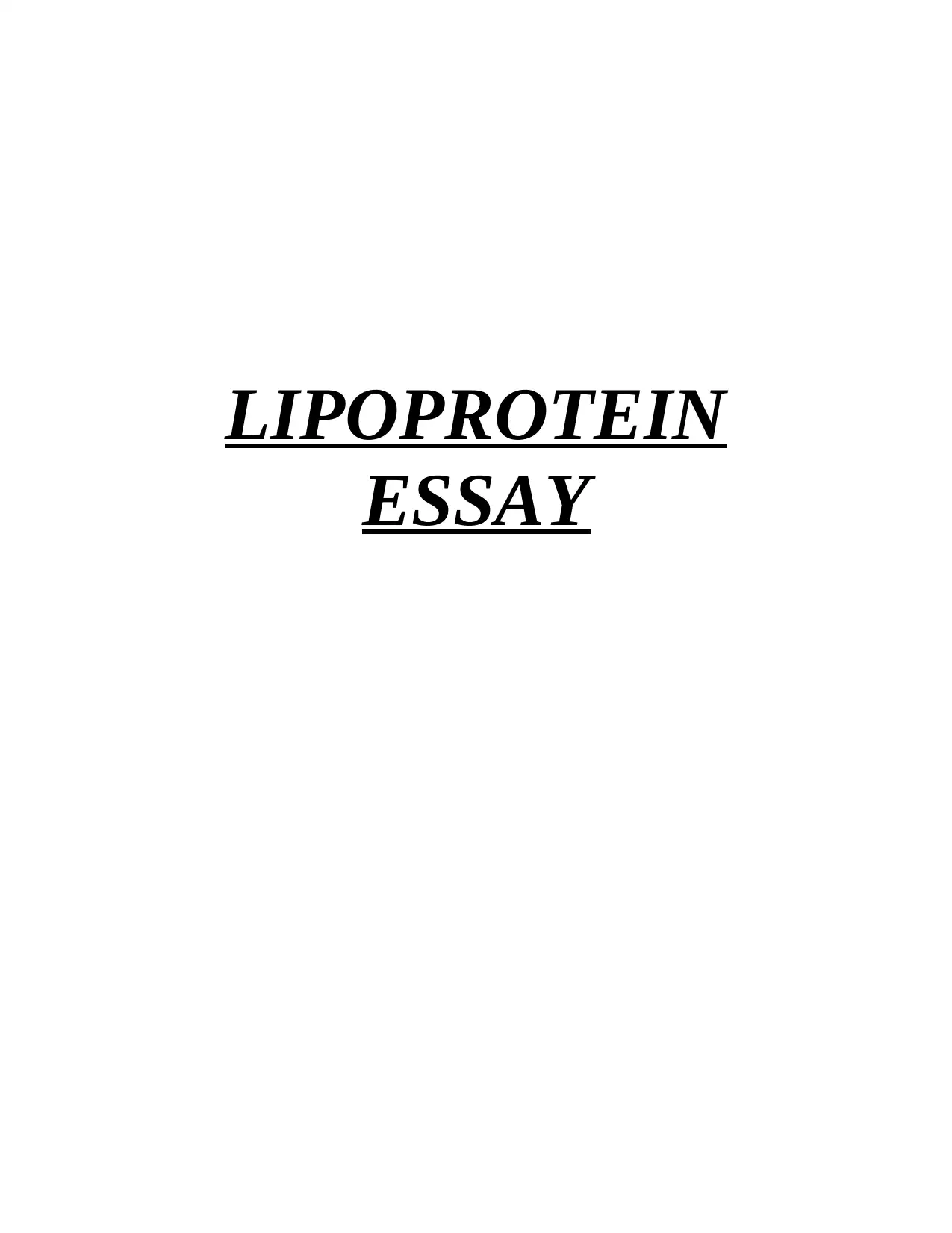
LIPOPROTEIN
ESSAY
ESSAY
Secure Best Marks with AI Grader
Need help grading? Try our AI Grader for instant feedback on your assignments.
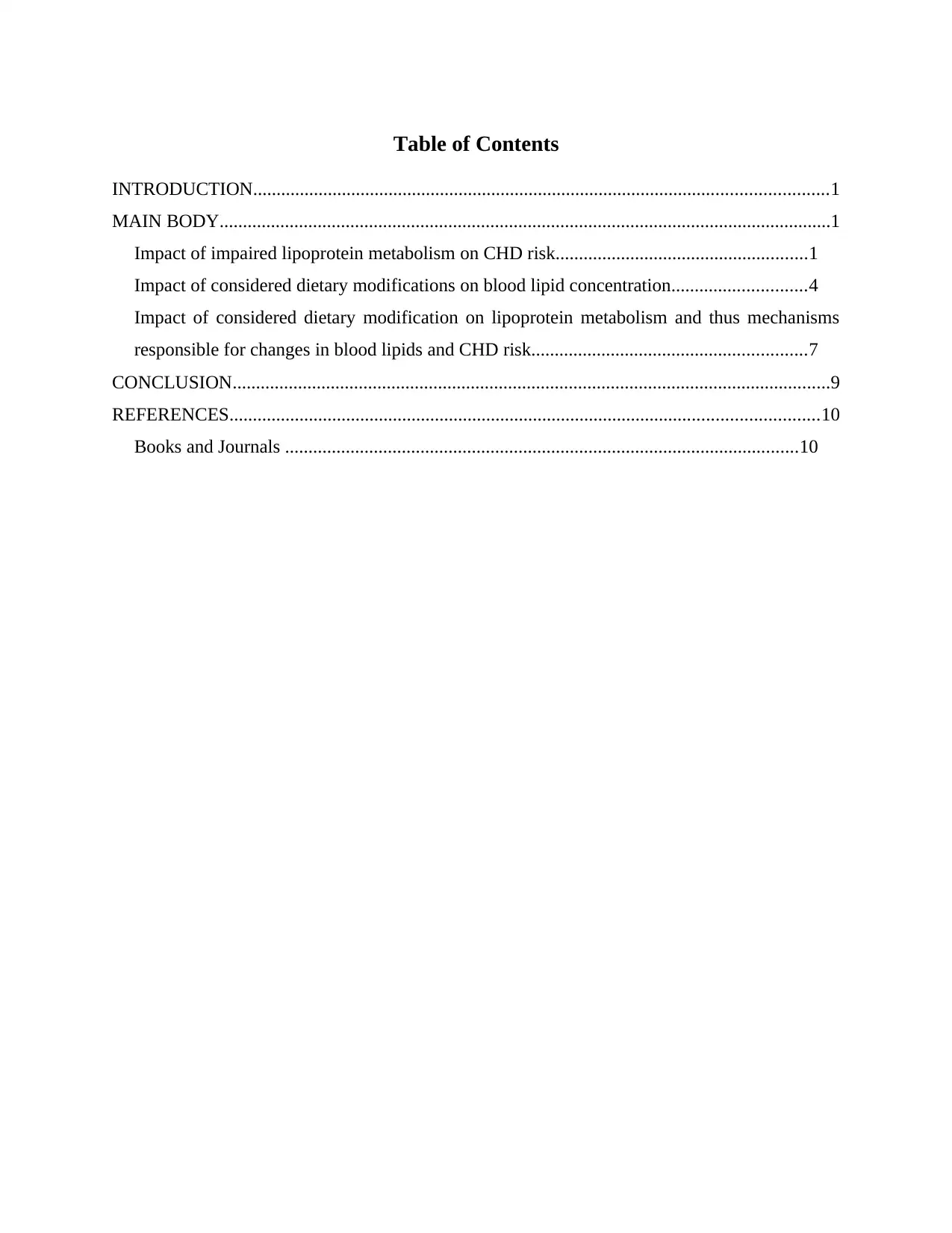
Table of Contents
INTRODUCTION...........................................................................................................................1
MAIN BODY...................................................................................................................................1
Impact of impaired lipoprotein metabolism on CHD risk......................................................1
Impact of considered dietary modifications on blood lipid concentration.............................4
Impact of considered dietary modification on lipoprotein metabolism and thus mechanisms
responsible for changes in blood lipids and CHD risk...........................................................7
CONCLUSION................................................................................................................................9
REFERENCES..............................................................................................................................10
Books and Journals ..............................................................................................................10
INTRODUCTION...........................................................................................................................1
MAIN BODY...................................................................................................................................1
Impact of impaired lipoprotein metabolism on CHD risk......................................................1
Impact of considered dietary modifications on blood lipid concentration.............................4
Impact of considered dietary modification on lipoprotein metabolism and thus mechanisms
responsible for changes in blood lipids and CHD risk...........................................................7
CONCLUSION................................................................................................................................9
REFERENCES..............................................................................................................................10
Books and Journals ..............................................................................................................10
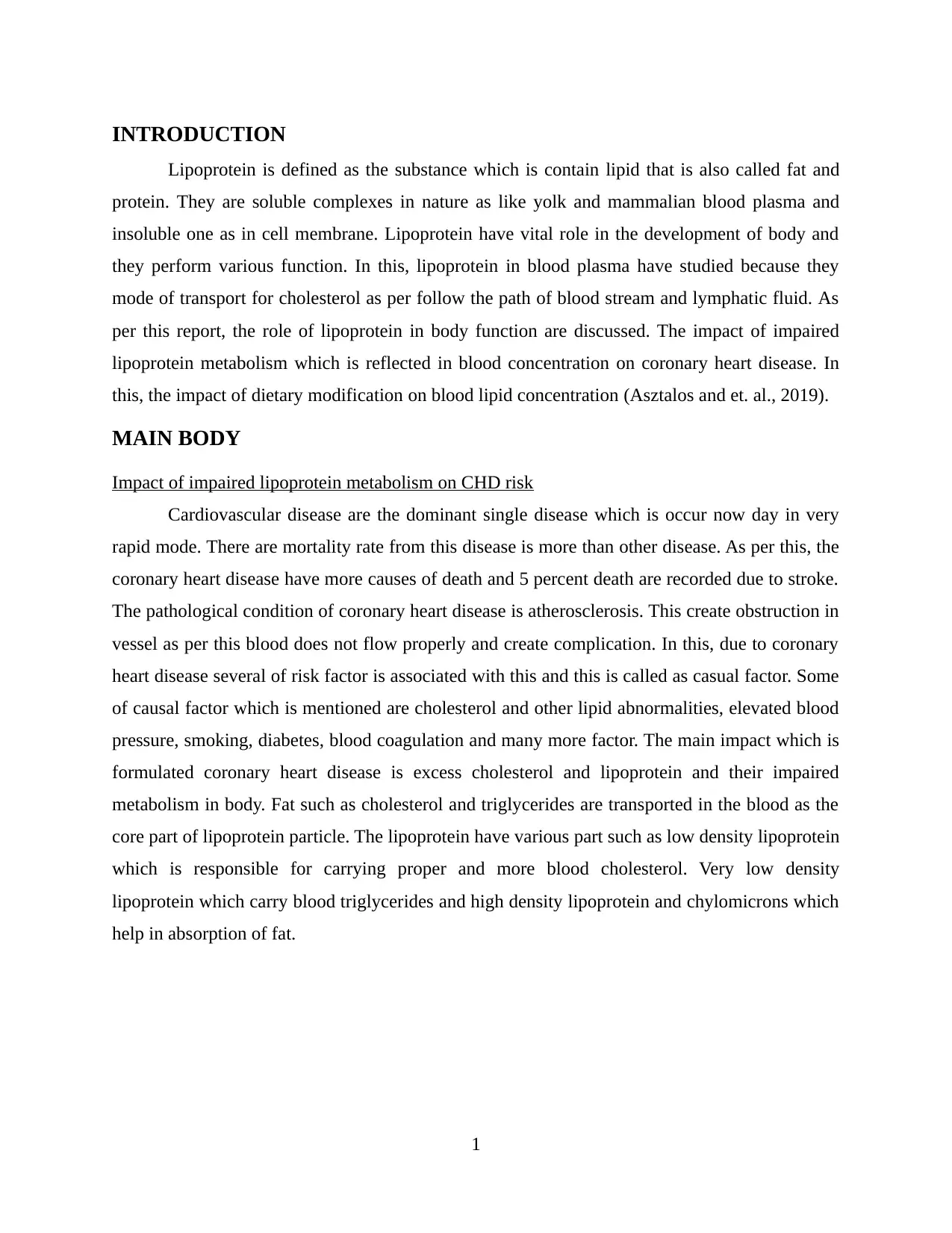
INTRODUCTION
Lipoprotein is defined as the substance which is contain lipid that is also called fat and
protein. They are soluble complexes in nature as like yolk and mammalian blood plasma and
insoluble one as in cell membrane. Lipoprotein have vital role in the development of body and
they perform various function. In this, lipoprotein in blood plasma have studied because they
mode of transport for cholesterol as per follow the path of blood stream and lymphatic fluid. As
per this report, the role of lipoprotein in body function are discussed. The impact of impaired
lipoprotein metabolism which is reflected in blood concentration on coronary heart disease. In
this, the impact of dietary modification on blood lipid concentration (Asztalos and et. al., 2019).
MAIN BODY
Impact of impaired lipoprotein metabolism on CHD risk
Cardiovascular disease are the dominant single disease which is occur now day in very
rapid mode. There are mortality rate from this disease is more than other disease. As per this, the
coronary heart disease have more causes of death and 5 percent death are recorded due to stroke.
The pathological condition of coronary heart disease is atherosclerosis. This create obstruction in
vessel as per this blood does not flow properly and create complication. In this, due to coronary
heart disease several of risk factor is associated with this and this is called as casual factor. Some
of causal factor which is mentioned are cholesterol and other lipid abnormalities, elevated blood
pressure, smoking, diabetes, blood coagulation and many more factor. The main impact which is
formulated coronary heart disease is excess cholesterol and lipoprotein and their impaired
metabolism in body. Fat such as cholesterol and triglycerides are transported in the blood as the
core part of lipoprotein particle. The lipoprotein have various part such as low density lipoprotein
which is responsible for carrying proper and more blood cholesterol. Very low density
lipoprotein which carry blood triglycerides and high density lipoprotein and chylomicrons which
help in absorption of fat.
1
Lipoprotein is defined as the substance which is contain lipid that is also called fat and
protein. They are soluble complexes in nature as like yolk and mammalian blood plasma and
insoluble one as in cell membrane. Lipoprotein have vital role in the development of body and
they perform various function. In this, lipoprotein in blood plasma have studied because they
mode of transport for cholesterol as per follow the path of blood stream and lymphatic fluid. As
per this report, the role of lipoprotein in body function are discussed. The impact of impaired
lipoprotein metabolism which is reflected in blood concentration on coronary heart disease. In
this, the impact of dietary modification on blood lipid concentration (Asztalos and et. al., 2019).
MAIN BODY
Impact of impaired lipoprotein metabolism on CHD risk
Cardiovascular disease are the dominant single disease which is occur now day in very
rapid mode. There are mortality rate from this disease is more than other disease. As per this, the
coronary heart disease have more causes of death and 5 percent death are recorded due to stroke.
The pathological condition of coronary heart disease is atherosclerosis. This create obstruction in
vessel as per this blood does not flow properly and create complication. In this, due to coronary
heart disease several of risk factor is associated with this and this is called as casual factor. Some
of causal factor which is mentioned are cholesterol and other lipid abnormalities, elevated blood
pressure, smoking, diabetes, blood coagulation and many more factor. The main impact which is
formulated coronary heart disease is excess cholesterol and lipoprotein and their impaired
metabolism in body. Fat such as cholesterol and triglycerides are transported in the blood as the
core part of lipoprotein particle. The lipoprotein have various part such as low density lipoprotein
which is responsible for carrying proper and more blood cholesterol. Very low density
lipoprotein which carry blood triglycerides and high density lipoprotein and chylomicrons which
help in absorption of fat.
1
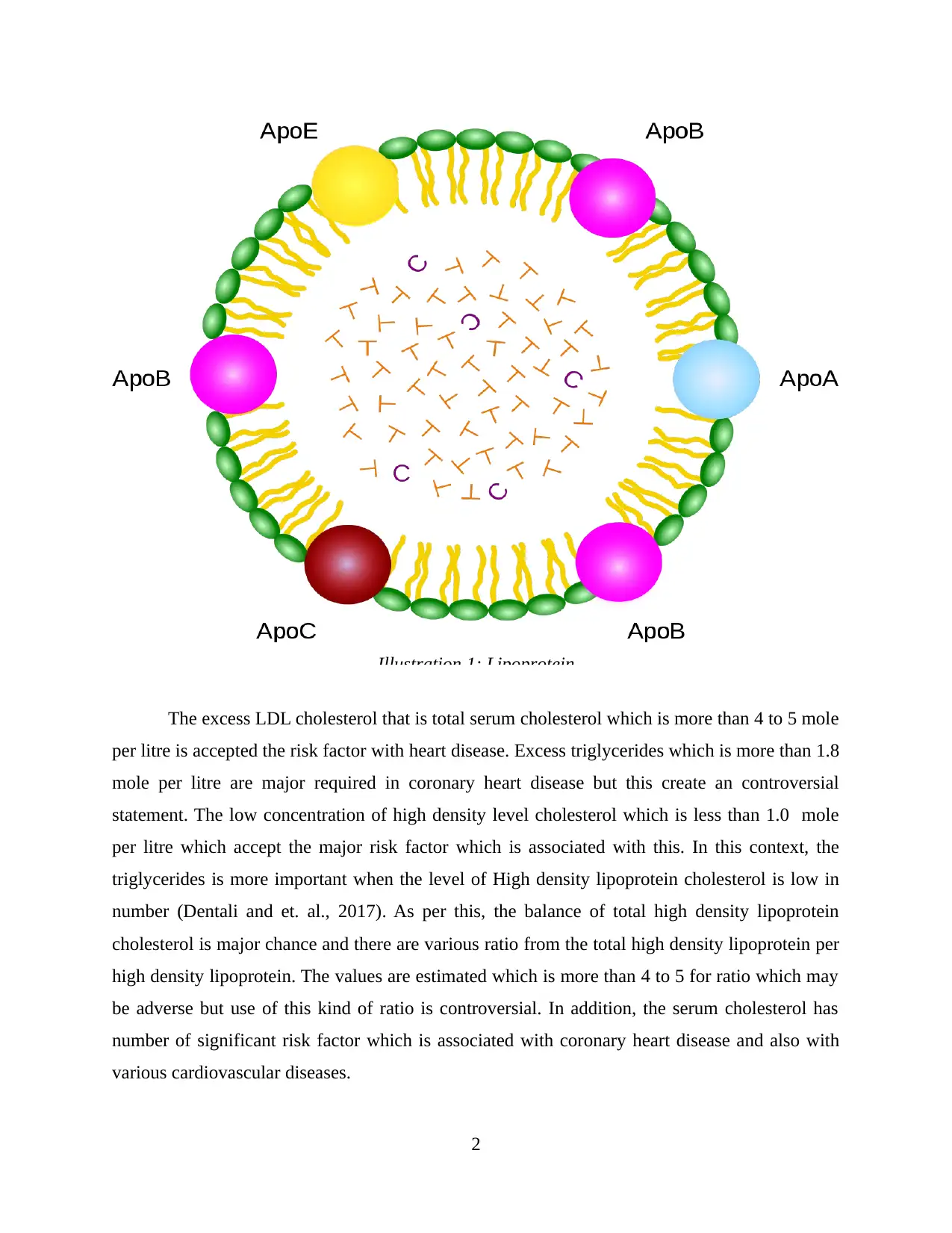
The excess LDL cholesterol that is total serum cholesterol which is more than 4 to 5 mole
per litre is accepted the risk factor with heart disease. Excess triglycerides which is more than 1.8
mole per litre are major required in coronary heart disease but this create an controversial
statement. The low concentration of high density level cholesterol which is less than 1.0 mole
per litre which accept the major risk factor which is associated with this. In this context, the
triglycerides is more important when the level of High density lipoprotein cholesterol is low in
number (Dentali and et. al., 2017). As per this, the balance of total high density lipoprotein
cholesterol is major chance and there are various ratio from the total high density lipoprotein per
high density lipoprotein. The values are estimated which is more than 4 to 5 for ratio which may
be adverse but use of this kind of ratio is controversial. In addition, the serum cholesterol has
number of significant risk factor which is associated with coronary heart disease and also with
various cardiovascular diseases.
2
Illustration 1: Lipoprotein
per litre is accepted the risk factor with heart disease. Excess triglycerides which is more than 1.8
mole per litre are major required in coronary heart disease but this create an controversial
statement. The low concentration of high density level cholesterol which is less than 1.0 mole
per litre which accept the major risk factor which is associated with this. In this context, the
triglycerides is more important when the level of High density lipoprotein cholesterol is low in
number (Dentali and et. al., 2017). As per this, the balance of total high density lipoprotein
cholesterol is major chance and there are various ratio from the total high density lipoprotein per
high density lipoprotein. The values are estimated which is more than 4 to 5 for ratio which may
be adverse but use of this kind of ratio is controversial. In addition, the serum cholesterol has
number of significant risk factor which is associated with coronary heart disease and also with
various cardiovascular diseases.
2
Illustration 1: Lipoprotein
Secure Best Marks with AI Grader
Need help grading? Try our AI Grader for instant feedback on your assignments.
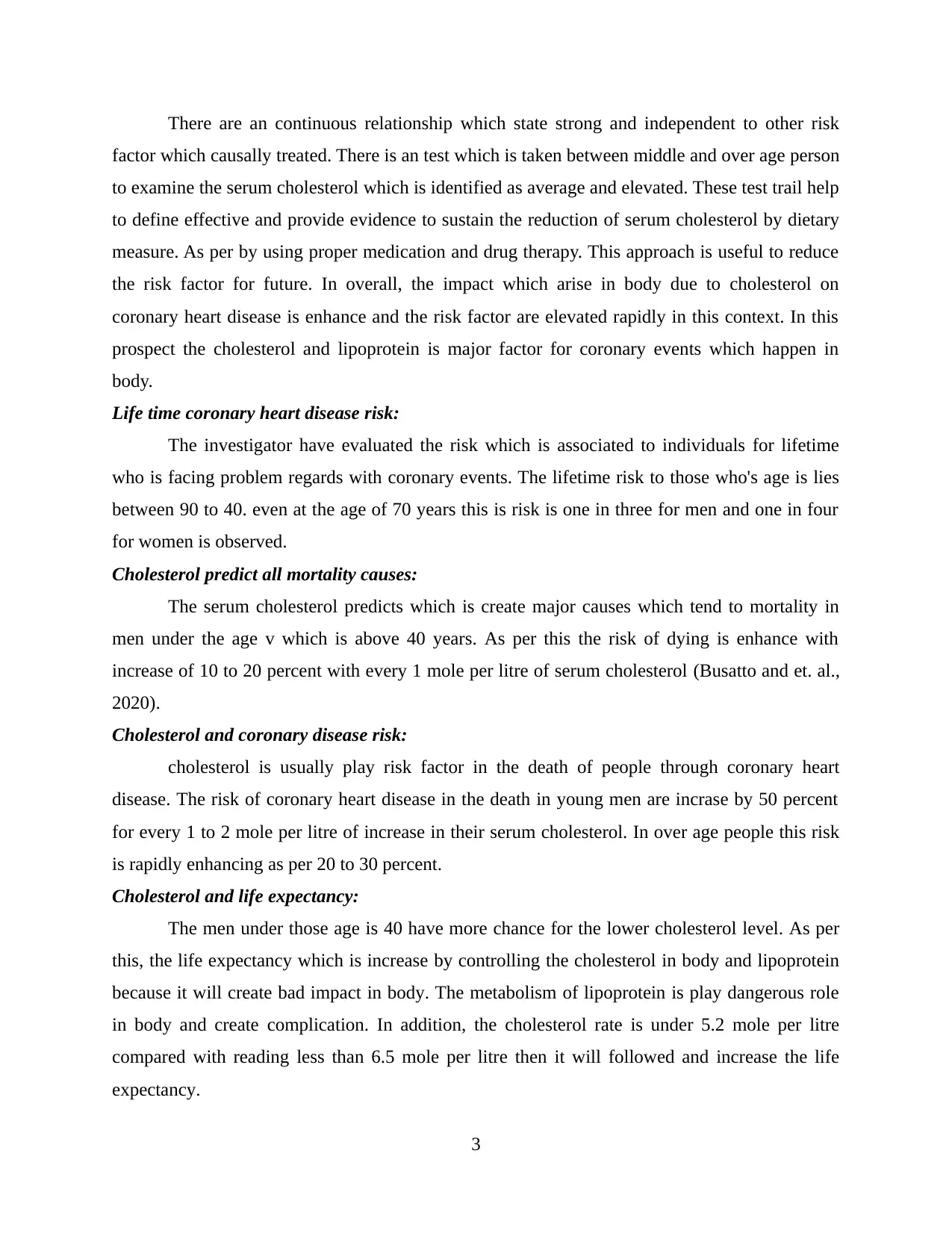
There are an continuous relationship which state strong and independent to other risk
factor which causally treated. There is an test which is taken between middle and over age person
to examine the serum cholesterol which is identified as average and elevated. These test trail help
to define effective and provide evidence to sustain the reduction of serum cholesterol by dietary
measure. As per by using proper medication and drug therapy. This approach is useful to reduce
the risk factor for future. In overall, the impact which arise in body due to cholesterol on
coronary heart disease is enhance and the risk factor are elevated rapidly in this context. In this
prospect the cholesterol and lipoprotein is major factor for coronary events which happen in
body.
Life time coronary heart disease risk:
The investigator have evaluated the risk which is associated to individuals for lifetime
who is facing problem regards with coronary events. The lifetime risk to those who's age is lies
between 90 to 40. even at the age of 70 years this is risk is one in three for men and one in four
for women is observed.
Cholesterol predict all mortality causes:
The serum cholesterol predicts which is create major causes which tend to mortality in
men under the age v which is above 40 years. As per this the risk of dying is enhance with
increase of 10 to 20 percent with every 1 mole per litre of serum cholesterol (Busatto and et. al.,
2020).
Cholesterol and coronary disease risk:
cholesterol is usually play risk factor in the death of people through coronary heart
disease. The risk of coronary heart disease in the death in young men are incrase by 50 percent
for every 1 to 2 mole per litre of increase in their serum cholesterol. In over age people this risk
is rapidly enhancing as per 20 to 30 percent.
Cholesterol and life expectancy:
The men under those age is 40 have more chance for the lower cholesterol level. As per
this, the life expectancy which is increase by controlling the cholesterol in body and lipoprotein
because it will create bad impact in body. The metabolism of lipoprotein is play dangerous role
in body and create complication. In addition, the cholesterol rate is under 5.2 mole per litre
compared with reading less than 6.5 mole per litre then it will followed and increase the life
expectancy.
3
factor which causally treated. There is an test which is taken between middle and over age person
to examine the serum cholesterol which is identified as average and elevated. These test trail help
to define effective and provide evidence to sustain the reduction of serum cholesterol by dietary
measure. As per by using proper medication and drug therapy. This approach is useful to reduce
the risk factor for future. In overall, the impact which arise in body due to cholesterol on
coronary heart disease is enhance and the risk factor are elevated rapidly in this context. In this
prospect the cholesterol and lipoprotein is major factor for coronary events which happen in
body.
Life time coronary heart disease risk:
The investigator have evaluated the risk which is associated to individuals for lifetime
who is facing problem regards with coronary events. The lifetime risk to those who's age is lies
between 90 to 40. even at the age of 70 years this is risk is one in three for men and one in four
for women is observed.
Cholesterol predict all mortality causes:
The serum cholesterol predicts which is create major causes which tend to mortality in
men under the age v which is above 40 years. As per this the risk of dying is enhance with
increase of 10 to 20 percent with every 1 mole per litre of serum cholesterol (Busatto and et. al.,
2020).
Cholesterol and coronary disease risk:
cholesterol is usually play risk factor in the death of people through coronary heart
disease. The risk of coronary heart disease in the death in young men are incrase by 50 percent
for every 1 to 2 mole per litre of increase in their serum cholesterol. In over age people this risk
is rapidly enhancing as per 20 to 30 percent.
Cholesterol and life expectancy:
The men under those age is 40 have more chance for the lower cholesterol level. As per
this, the life expectancy which is increase by controlling the cholesterol in body and lipoprotein
because it will create bad impact in body. The metabolism of lipoprotein is play dangerous role
in body and create complication. In addition, the cholesterol rate is under 5.2 mole per litre
compared with reading less than 6.5 mole per litre then it will followed and increase the life
expectancy.
3
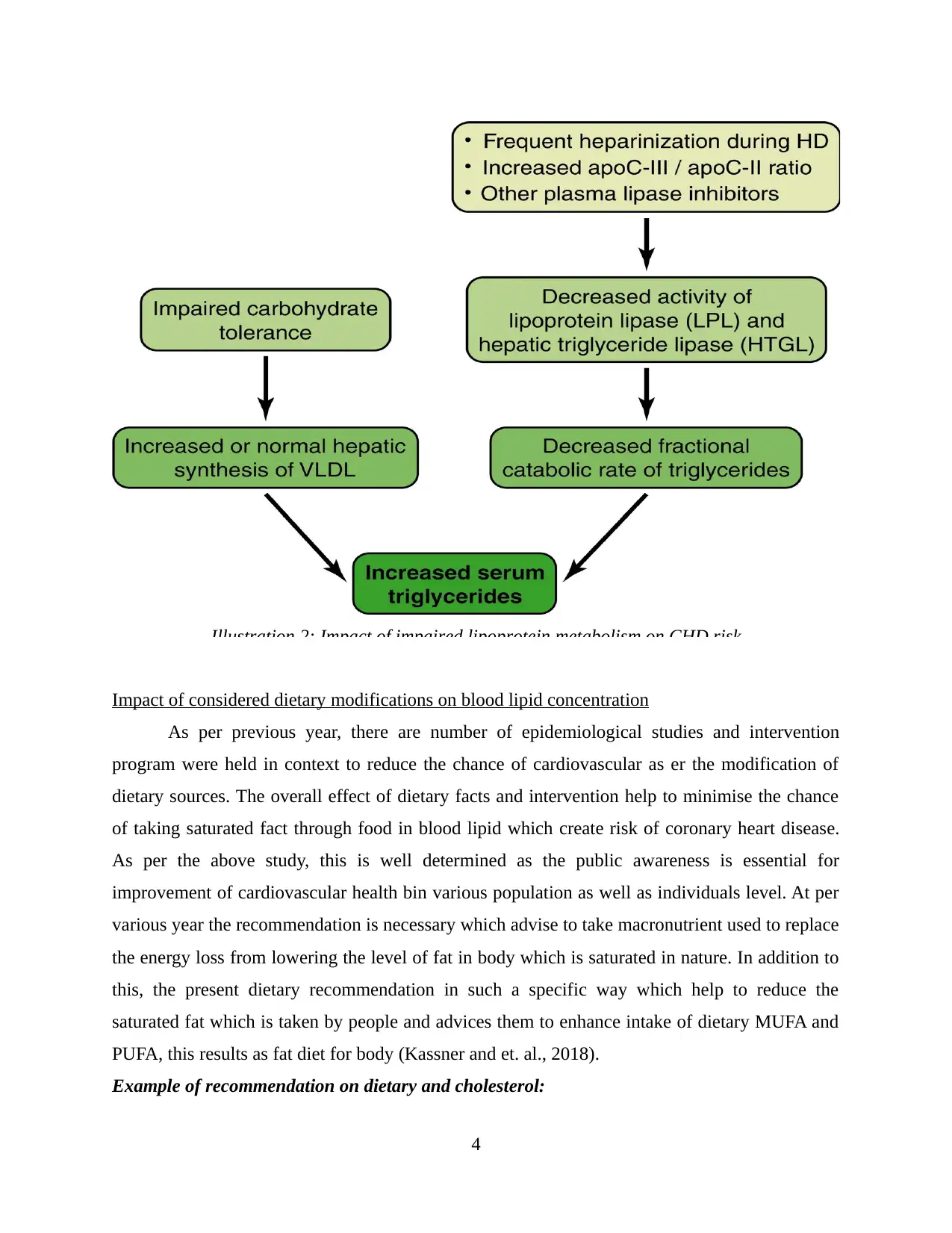
Impact of considered dietary modifications on blood lipid concentration
As per previous year, there are number of epidemiological studies and intervention
program were held in context to reduce the chance of cardiovascular as er the modification of
dietary sources. The overall effect of dietary facts and intervention help to minimise the chance
of taking saturated fact through food in blood lipid which create risk of coronary heart disease.
As per the above study, this is well determined as the public awareness is essential for
improvement of cardiovascular health bin various population as well as individuals level. At per
various year the recommendation is necessary which advise to take macronutrient used to replace
the energy loss from lowering the level of fat in body which is saturated in nature. In addition to
this, the present dietary recommendation in such a specific way which help to reduce the
saturated fat which is taken by people and advices them to enhance intake of dietary MUFA and
PUFA, this results as fat diet for body (Kassner and et. al., 2018).
Example of recommendation on dietary and cholesterol:
4
Illustration 2: Impact of impaired lipoprotein metabolism on CHD risk
As per previous year, there are number of epidemiological studies and intervention
program were held in context to reduce the chance of cardiovascular as er the modification of
dietary sources. The overall effect of dietary facts and intervention help to minimise the chance
of taking saturated fact through food in blood lipid which create risk of coronary heart disease.
As per the above study, this is well determined as the public awareness is essential for
improvement of cardiovascular health bin various population as well as individuals level. At per
various year the recommendation is necessary which advise to take macronutrient used to replace
the energy loss from lowering the level of fat in body which is saturated in nature. In addition to
this, the present dietary recommendation in such a specific way which help to reduce the
saturated fat which is taken by people and advices them to enhance intake of dietary MUFA and
PUFA, this results as fat diet for body (Kassner and et. al., 2018).
Example of recommendation on dietary and cholesterol:
4
Illustration 2: Impact of impaired lipoprotein metabolism on CHD risk
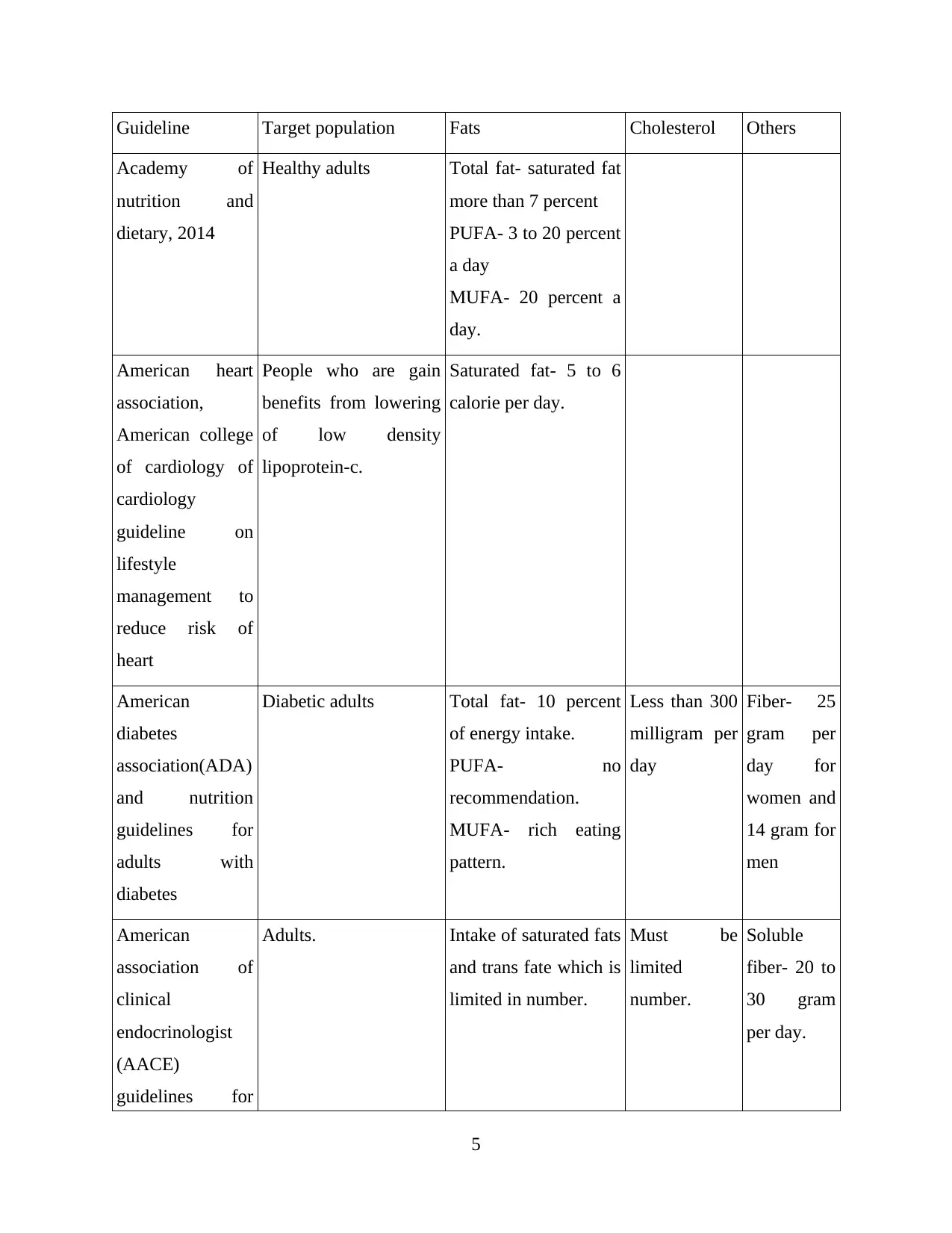
Guideline Target population Fats Cholesterol Others
Academy of
nutrition and
dietary, 2014
Healthy adults Total fat- saturated fat
more than 7 percent
PUFA- 3 to 20 percent
a day
MUFA- 20 percent a
day.
American heart
association,
American college
of cardiology of
cardiology
guideline on
lifestyle
management to
reduce risk of
heart
People who are gain
benefits from lowering
of low density
lipoprotein-c.
Saturated fat- 5 to 6
calorie per day.
American
diabetes
association(ADA)
and nutrition
guidelines for
adults with
diabetes
Diabetic adults Total fat- 10 percent
of energy intake.
PUFA- no
recommendation.
MUFA- rich eating
pattern.
Less than 300
milligram per
day
Fiber- 25
gram per
day for
women and
14 gram for
men
American
association of
clinical
endocrinologist
(AACE)
guidelines for
Adults. Intake of saturated fats
and trans fate which is
limited in number.
Must be
limited
number.
Soluble
fiber- 20 to
30 gram
per day.
5
Academy of
nutrition and
dietary, 2014
Healthy adults Total fat- saturated fat
more than 7 percent
PUFA- 3 to 20 percent
a day
MUFA- 20 percent a
day.
American heart
association,
American college
of cardiology of
cardiology
guideline on
lifestyle
management to
reduce risk of
heart
People who are gain
benefits from lowering
of low density
lipoprotein-c.
Saturated fat- 5 to 6
calorie per day.
American
diabetes
association(ADA)
and nutrition
guidelines for
adults with
diabetes
Diabetic adults Total fat- 10 percent
of energy intake.
PUFA- no
recommendation.
MUFA- rich eating
pattern.
Less than 300
milligram per
day
Fiber- 25
gram per
day for
women and
14 gram for
men
American
association of
clinical
endocrinologist
(AACE)
guidelines for
Adults. Intake of saturated fats
and trans fate which is
limited in number.
Must be
limited
number.
Soluble
fiber- 20 to
30 gram
per day.
5
Paraphrase This Document
Need a fresh take? Get an instant paraphrase of this document with our AI Paraphraser
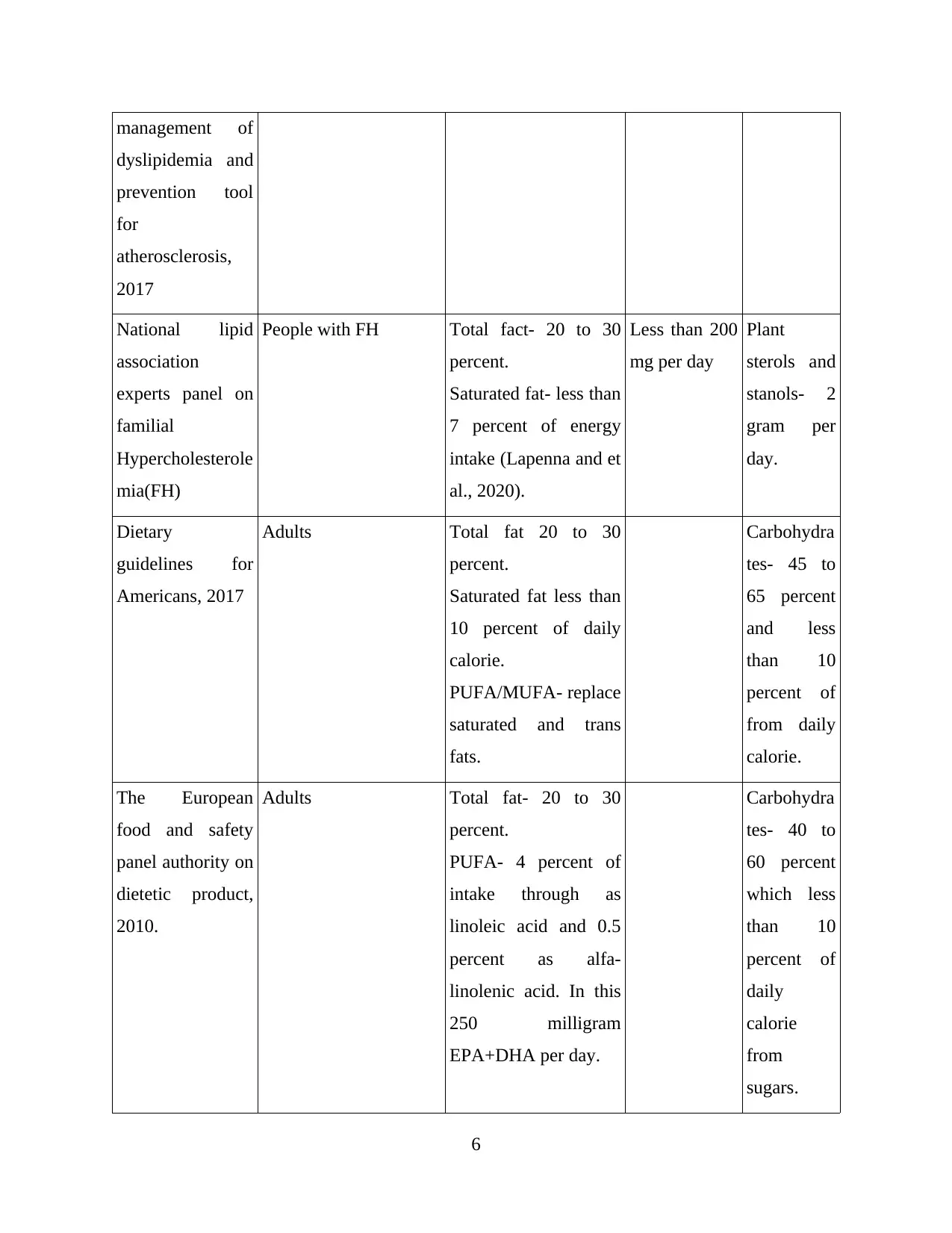
management of
dyslipidemia and
prevention tool
for
atherosclerosis,
2017
National lipid
association
experts panel on
familial
Hypercholesterole
mia(FH)
People with FH Total fact- 20 to 30
percent.
Saturated fat- less than
7 percent of energy
intake (Lapenna and et
al., 2020).
Less than 200
mg per day
Plant
sterols and
stanols- 2
gram per
day.
Dietary
guidelines for
Americans, 2017
Adults Total fat 20 to 30
percent.
Saturated fat less than
10 percent of daily
calorie.
PUFA/MUFA- replace
saturated and trans
fats.
Carbohydra
tes- 45 to
65 percent
and less
than 10
percent of
from daily
calorie.
The European
food and safety
panel authority on
dietetic product,
2010.
Adults Total fat- 20 to 30
percent.
PUFA- 4 percent of
intake through as
linoleic acid and 0.5
percent as alfa-
linolenic acid. In this
250 milligram
EPA+DHA per day.
Carbohydra
tes- 40 to
60 percent
which less
than 10
percent of
daily
calorie
from
sugars.
6
dyslipidemia and
prevention tool
for
atherosclerosis,
2017
National lipid
association
experts panel on
familial
Hypercholesterole
mia(FH)
People with FH Total fact- 20 to 30
percent.
Saturated fat- less than
7 percent of energy
intake (Lapenna and et
al., 2020).
Less than 200
mg per day
Plant
sterols and
stanols- 2
gram per
day.
Dietary
guidelines for
Americans, 2017
Adults Total fat 20 to 30
percent.
Saturated fat less than
10 percent of daily
calorie.
PUFA/MUFA- replace
saturated and trans
fats.
Carbohydra
tes- 45 to
65 percent
and less
than 10
percent of
from daily
calorie.
The European
food and safety
panel authority on
dietetic product,
2010.
Adults Total fat- 20 to 30
percent.
PUFA- 4 percent of
intake through as
linoleic acid and 0.5
percent as alfa-
linolenic acid. In this
250 milligram
EPA+DHA per day.
Carbohydra
tes- 40 to
60 percent
which less
than 10
percent of
daily
calorie
from
sugars.
6
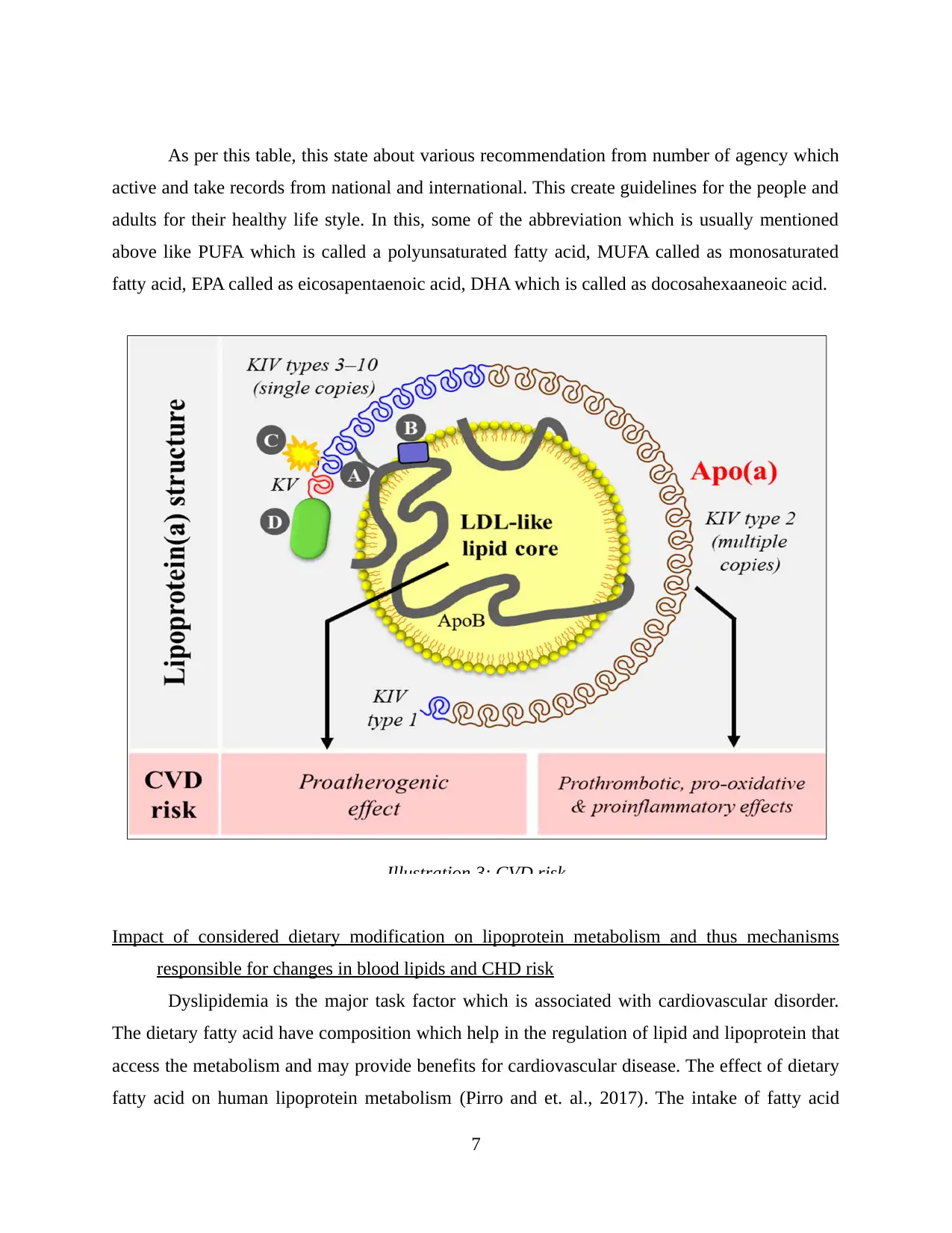
As per this table, this state about various recommendation from number of agency which
active and take records from national and international. This create guidelines for the people and
adults for their healthy life style. In this, some of the abbreviation which is usually mentioned
above like PUFA which is called a polyunsaturated fatty acid, MUFA called as monosaturated
fatty acid, EPA called as eicosapentaenoic acid, DHA which is called as docosahexaaneoic acid.
Impact of considered dietary modification on lipoprotein metabolism and thus mechanisms
responsible for changes in blood lipids and CHD risk
Dyslipidemia is the major task factor which is associated with cardiovascular disorder.
The dietary fatty acid have composition which help in the regulation of lipid and lipoprotein that
access the metabolism and may provide benefits for cardiovascular disease. The effect of dietary
fatty acid on human lipoprotein metabolism (Pirro and et. al., 2017). The intake of fatty acid
7
Illustration 3: CVD risk
active and take records from national and international. This create guidelines for the people and
adults for their healthy life style. In this, some of the abbreviation which is usually mentioned
above like PUFA which is called a polyunsaturated fatty acid, MUFA called as monosaturated
fatty acid, EPA called as eicosapentaenoic acid, DHA which is called as docosahexaaneoic acid.
Impact of considered dietary modification on lipoprotein metabolism and thus mechanisms
responsible for changes in blood lipids and CHD risk
Dyslipidemia is the major task factor which is associated with cardiovascular disorder.
The dietary fatty acid have composition which help in the regulation of lipid and lipoprotein that
access the metabolism and may provide benefits for cardiovascular disease. The effect of dietary
fatty acid on human lipoprotein metabolism (Pirro and et. al., 2017). The intake of fatty acid
7
Illustration 3: CVD risk
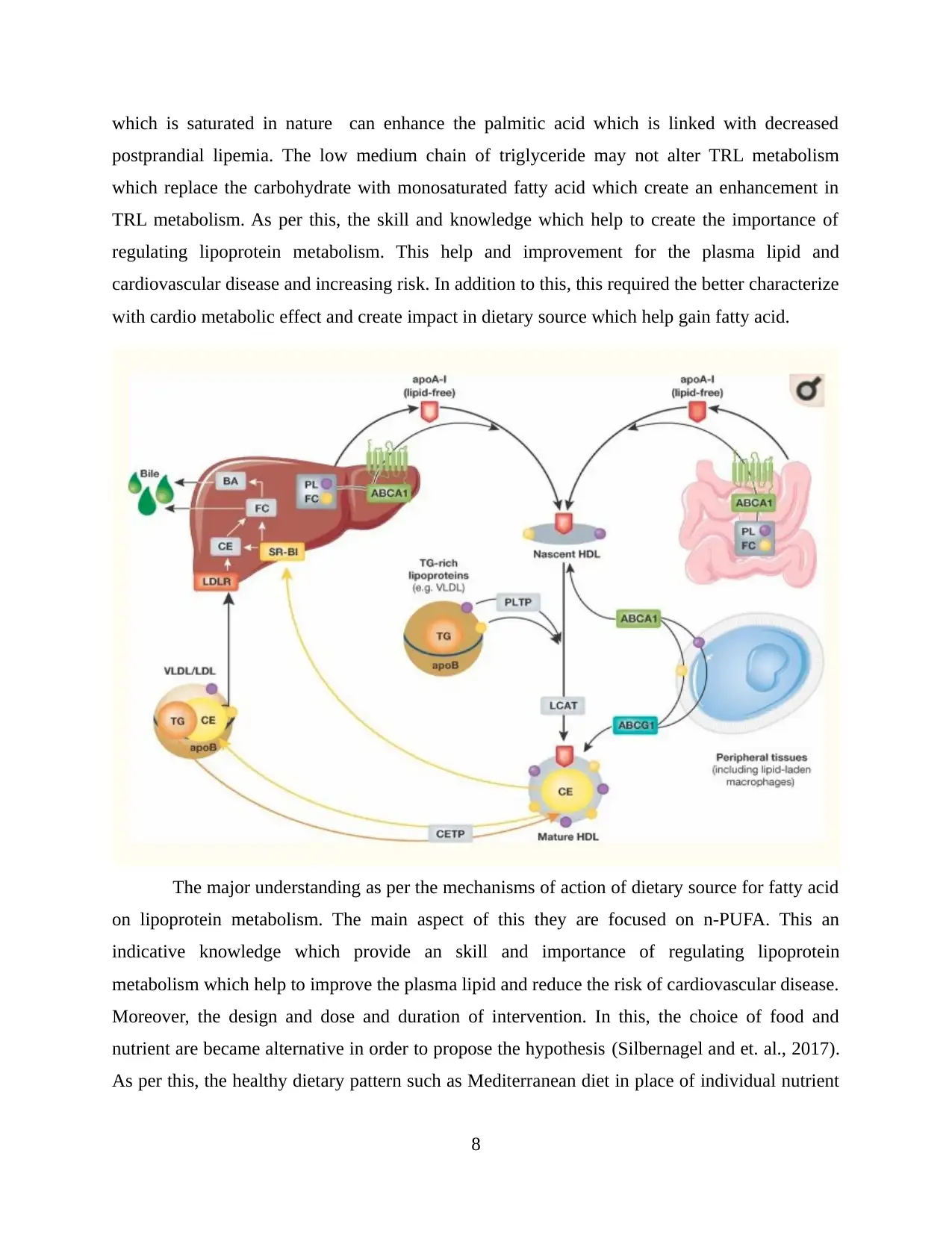
which is saturated in nature can enhance the palmitic acid which is linked with decreased
postprandial lipemia. The low medium chain of triglyceride may not alter TRL metabolism
which replace the carbohydrate with monosaturated fatty acid which create an enhancement in
TRL metabolism. As per this, the skill and knowledge which help to create the importance of
regulating lipoprotein metabolism. This help and improvement for the plasma lipid and
cardiovascular disease and increasing risk. In addition to this, this required the better characterize
with cardio metabolic effect and create impact in dietary source which help gain fatty acid.
The major understanding as per the mechanisms of action of dietary source for fatty acid
on lipoprotein metabolism. The main aspect of this they are focused on n-PUFA. This an
indicative knowledge which provide an skill and importance of regulating lipoprotein
metabolism which help to improve the plasma lipid and reduce the risk of cardiovascular disease.
Moreover, the design and dose and duration of intervention. In this, the choice of food and
nutrient are became alternative in order to propose the hypothesis (Silbernagel and et. al., 2017).
As per this, the healthy dietary pattern such as Mediterranean diet in place of individual nutrient
8
postprandial lipemia. The low medium chain of triglyceride may not alter TRL metabolism
which replace the carbohydrate with monosaturated fatty acid which create an enhancement in
TRL metabolism. As per this, the skill and knowledge which help to create the importance of
regulating lipoprotein metabolism. This help and improvement for the plasma lipid and
cardiovascular disease and increasing risk. In addition to this, this required the better characterize
with cardio metabolic effect and create impact in dietary source which help gain fatty acid.
The major understanding as per the mechanisms of action of dietary source for fatty acid
on lipoprotein metabolism. The main aspect of this they are focused on n-PUFA. This an
indicative knowledge which provide an skill and importance of regulating lipoprotein
metabolism which help to improve the plasma lipid and reduce the risk of cardiovascular disease.
Moreover, the design and dose and duration of intervention. In this, the choice of food and
nutrient are became alternative in order to propose the hypothesis (Silbernagel and et. al., 2017).
As per this, the healthy dietary pattern such as Mediterranean diet in place of individual nutrient
8
Secure Best Marks with AI Grader
Need help grading? Try our AI Grader for instant feedback on your assignments.
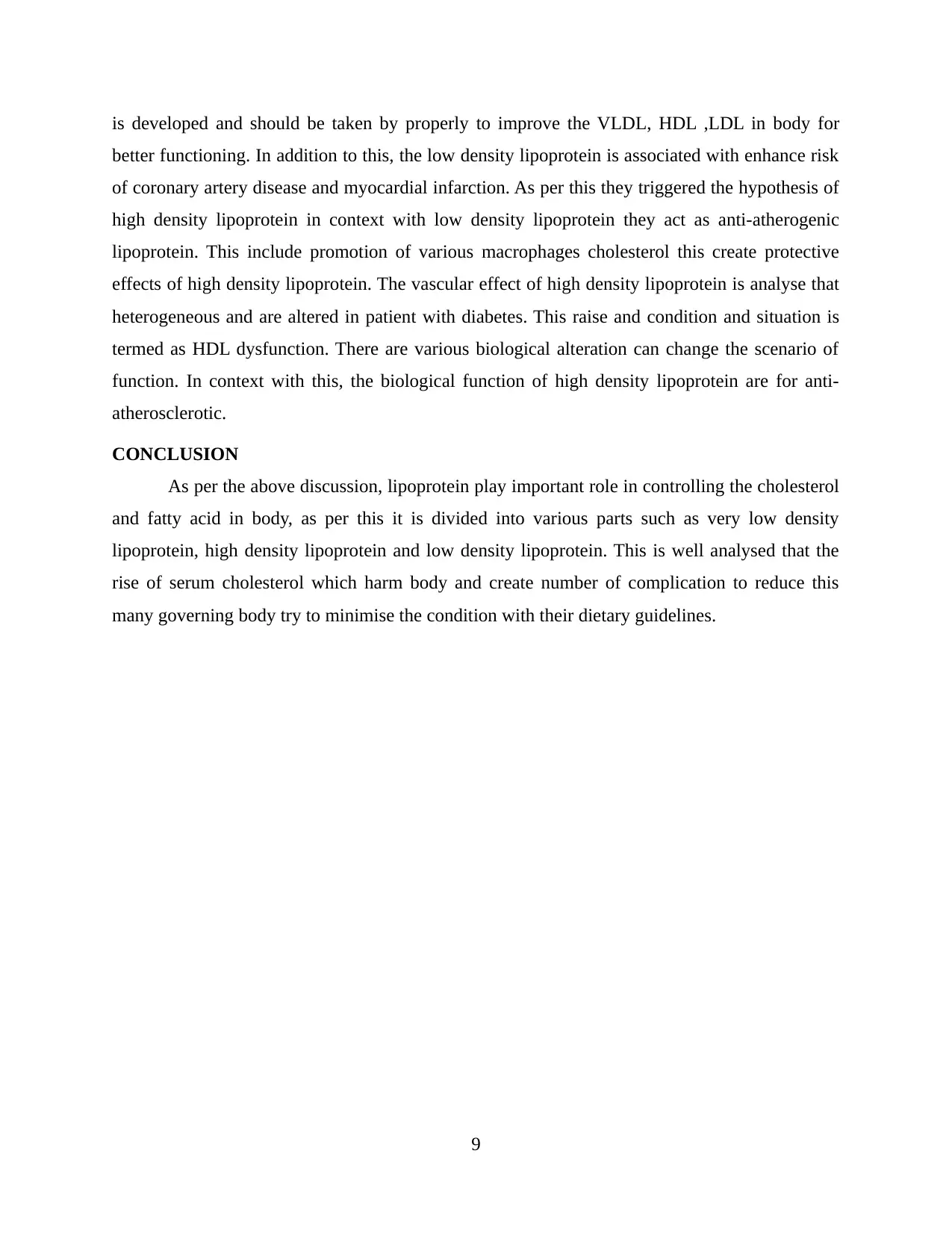
is developed and should be taken by properly to improve the VLDL, HDL ,LDL in body for
better functioning. In addition to this, the low density lipoprotein is associated with enhance risk
of coronary artery disease and myocardial infarction. As per this they triggered the hypothesis of
high density lipoprotein in context with low density lipoprotein they act as anti-atherogenic
lipoprotein. This include promotion of various macrophages cholesterol this create protective
effects of high density lipoprotein. The vascular effect of high density lipoprotein is analyse that
heterogeneous and are altered in patient with diabetes. This raise and condition and situation is
termed as HDL dysfunction. There are various biological alteration can change the scenario of
function. In context with this, the biological function of high density lipoprotein are for anti-
atherosclerotic.
CONCLUSION
As per the above discussion, lipoprotein play important role in controlling the cholesterol
and fatty acid in body, as per this it is divided into various parts such as very low density
lipoprotein, high density lipoprotein and low density lipoprotein. This is well analysed that the
rise of serum cholesterol which harm body and create number of complication to reduce this
many governing body try to minimise the condition with their dietary guidelines.
9
better functioning. In addition to this, the low density lipoprotein is associated with enhance risk
of coronary artery disease and myocardial infarction. As per this they triggered the hypothesis of
high density lipoprotein in context with low density lipoprotein they act as anti-atherogenic
lipoprotein. This include promotion of various macrophages cholesterol this create protective
effects of high density lipoprotein. The vascular effect of high density lipoprotein is analyse that
heterogeneous and are altered in patient with diabetes. This raise and condition and situation is
termed as HDL dysfunction. There are various biological alteration can change the scenario of
function. In context with this, the biological function of high density lipoprotein are for anti-
atherosclerotic.
CONCLUSION
As per the above discussion, lipoprotein play important role in controlling the cholesterol
and fatty acid in body, as per this it is divided into various parts such as very low density
lipoprotein, high density lipoprotein and low density lipoprotein. This is well analysed that the
rise of serum cholesterol which harm body and create number of complication to reduce this
many governing body try to minimise the condition with their dietary guidelines.
9
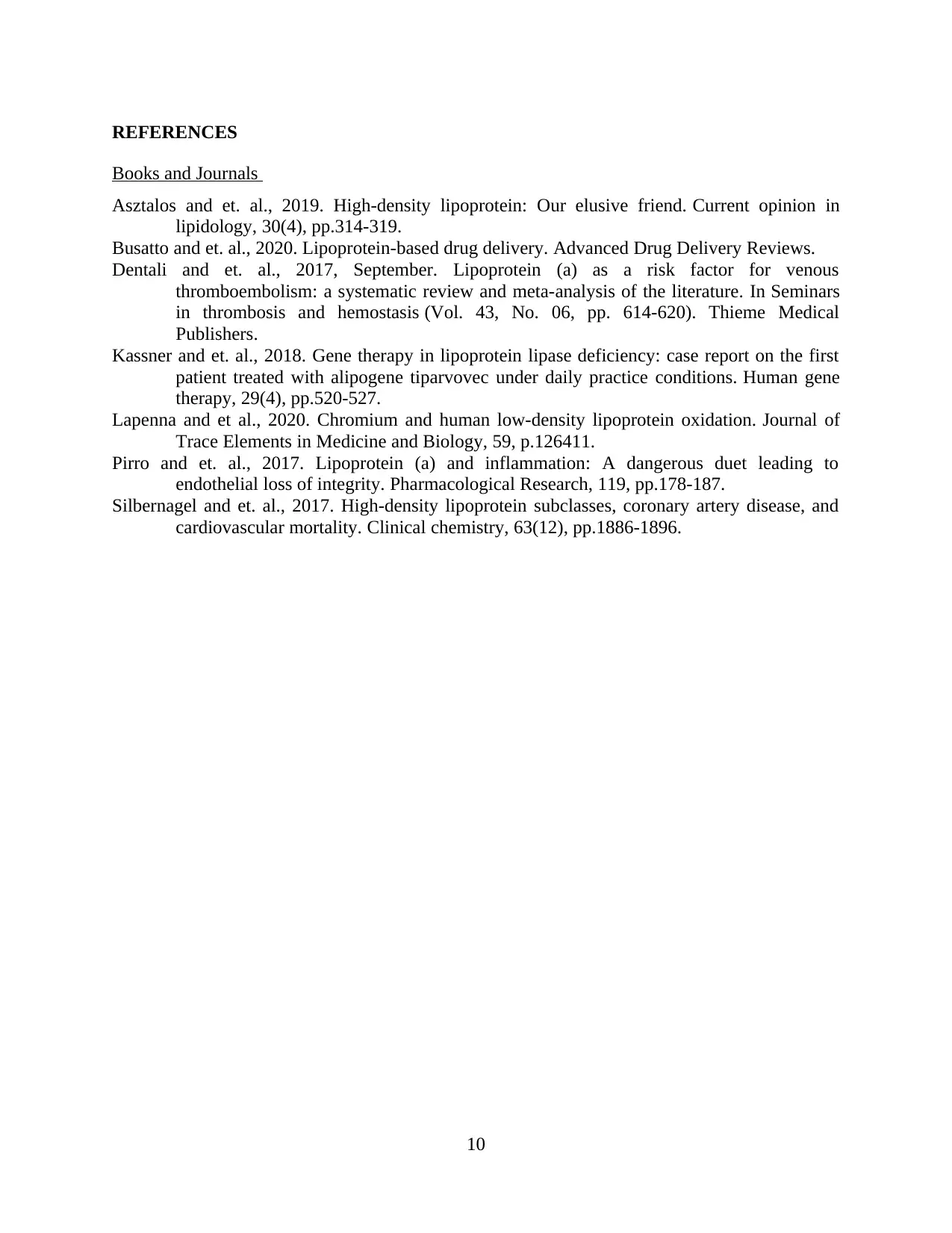
REFERENCES
Books and Journals
Asztalos and et. al., 2019. High-density lipoprotein: Our elusive friend. Current opinion in
lipidology, 30(4), pp.314-319.
Busatto and et. al., 2020. Lipoprotein-based drug delivery. Advanced Drug Delivery Reviews.
Dentali and et. al., 2017, September. Lipoprotein (a) as a risk factor for venous
thromboembolism: a systematic review and meta-analysis of the literature. In Seminars
in thrombosis and hemostasis (Vol. 43, No. 06, pp. 614-620). Thieme Medical
Publishers.
Kassner and et. al., 2018. Gene therapy in lipoprotein lipase deficiency: case report on the first
patient treated with alipogene tiparvovec under daily practice conditions. Human gene
therapy, 29(4), pp.520-527.
Lapenna and et al., 2020. Chromium and human low-density lipoprotein oxidation. Journal of
Trace Elements in Medicine and Biology, 59, p.126411.
Pirro and et. al., 2017. Lipoprotein (a) and inflammation: A dangerous duet leading to
endothelial loss of integrity. Pharmacological Research, 119, pp.178-187.
Silbernagel and et. al., 2017. High-density lipoprotein subclasses, coronary artery disease, and
cardiovascular mortality. Clinical chemistry, 63(12), pp.1886-1896.
10
Books and Journals
Asztalos and et. al., 2019. High-density lipoprotein: Our elusive friend. Current opinion in
lipidology, 30(4), pp.314-319.
Busatto and et. al., 2020. Lipoprotein-based drug delivery. Advanced Drug Delivery Reviews.
Dentali and et. al., 2017, September. Lipoprotein (a) as a risk factor for venous
thromboembolism: a systematic review and meta-analysis of the literature. In Seminars
in thrombosis and hemostasis (Vol. 43, No. 06, pp. 614-620). Thieme Medical
Publishers.
Kassner and et. al., 2018. Gene therapy in lipoprotein lipase deficiency: case report on the first
patient treated with alipogene tiparvovec under daily practice conditions. Human gene
therapy, 29(4), pp.520-527.
Lapenna and et al., 2020. Chromium and human low-density lipoprotein oxidation. Journal of
Trace Elements in Medicine and Biology, 59, p.126411.
Pirro and et. al., 2017. Lipoprotein (a) and inflammation: A dangerous duet leading to
endothelial loss of integrity. Pharmacological Research, 119, pp.178-187.
Silbernagel and et. al., 2017. High-density lipoprotein subclasses, coronary artery disease, and
cardiovascular mortality. Clinical chemistry, 63(12), pp.1886-1896.
10
1 out of 12
Related Documents
Your All-in-One AI-Powered Toolkit for Academic Success.
+13062052269
info@desklib.com
Available 24*7 on WhatsApp / Email
![[object Object]](/_next/static/media/star-bottom.7253800d.svg)
Unlock your academic potential
© 2024 | Zucol Services PVT LTD | All rights reserved.





